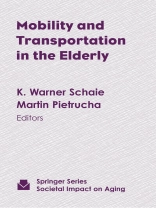This comprehensive volume examines the gradual reduction of mobility in the elderly. The authors first review the physiological and psychological changes that occur as we age, and go on to illustrate how this gradual decrease in adequate mobility can lead to an increase in automotive accidents. They also review the limitations that mass transportation systems and driving individual vehicles present for the elderly, and discuss different assistive devices that have been and should be implemented to help improve mobility. Each chapter ends with insightful commentaries by specialists in the gerontology field. This book is a must read for gerontologists as well as policy makers and educators on courses in organizational structures of social policy.
Tabela de Conteúdo
‘
Preface
Commentary: The Place of Ambient Vision in Understanding Problems of Mobility and Elderly,
D. Alfred Owens
Commentary: Countering Mobility Losses Due to Functional Impairments in Normally Aging Individuals: Applying Fozardís Framework to Everyday Driving Situations,
Loren Staplin
Commentary: Social Structures and Processes in Public and Private Transportation,
Harvey L. Sterns and Ronni Sterns
Commentary: Into the Transportation Future,
Katherine Freund
Commentary: What do Driving Accident Patterns Reveal about Age-Related Changed in Visual Information Processing?
Frank Schieber
Commentary,
Allen Dobbs
Commentary,
Sherry L. Willis
Commentary,
Richard Marottoli
Commentary: Intelligent Transportation Systems and the Older Driver: An Auto Industry Perspective,
Thomas F. Swigart
Commentary: Intelligent Transportation Systems and the Older Traveler: Prospects for Mobility Enhancements,
Paul P. Jovanis
‘












